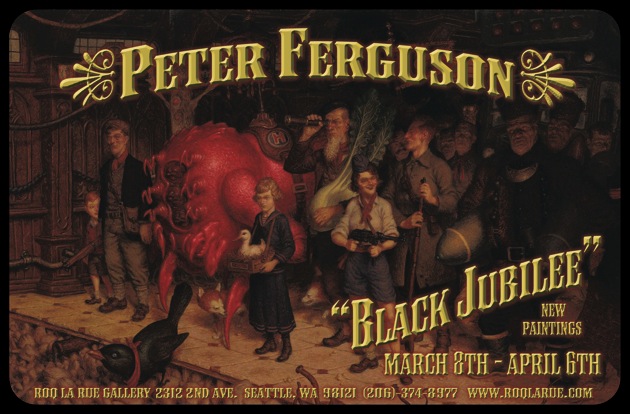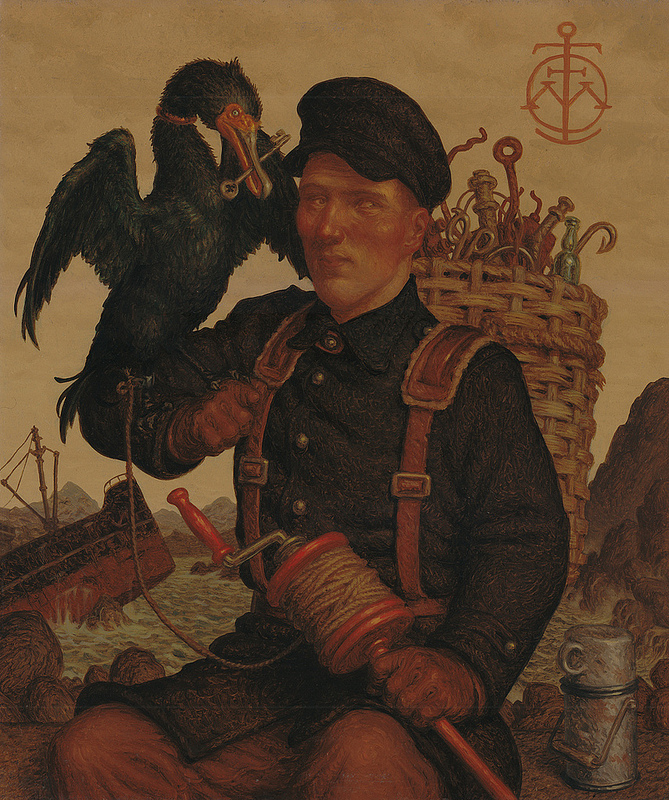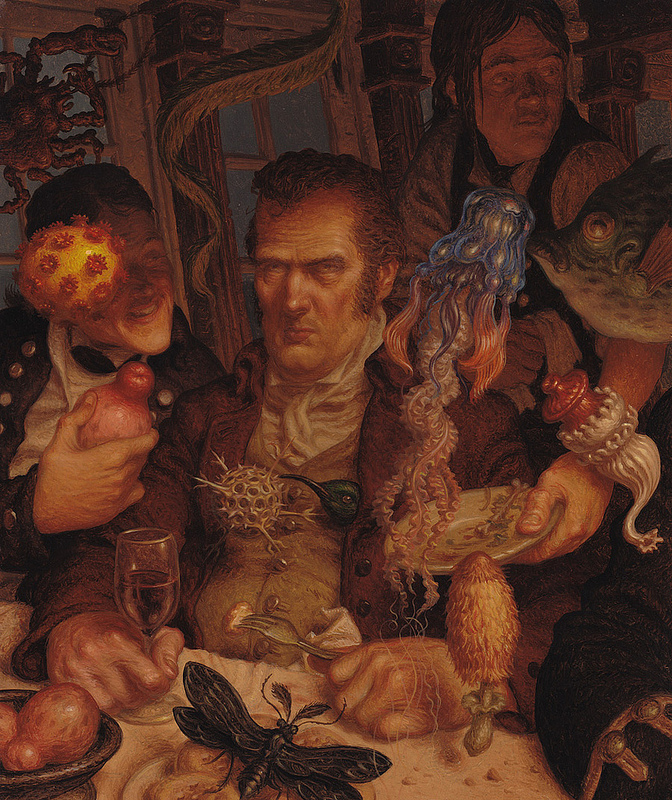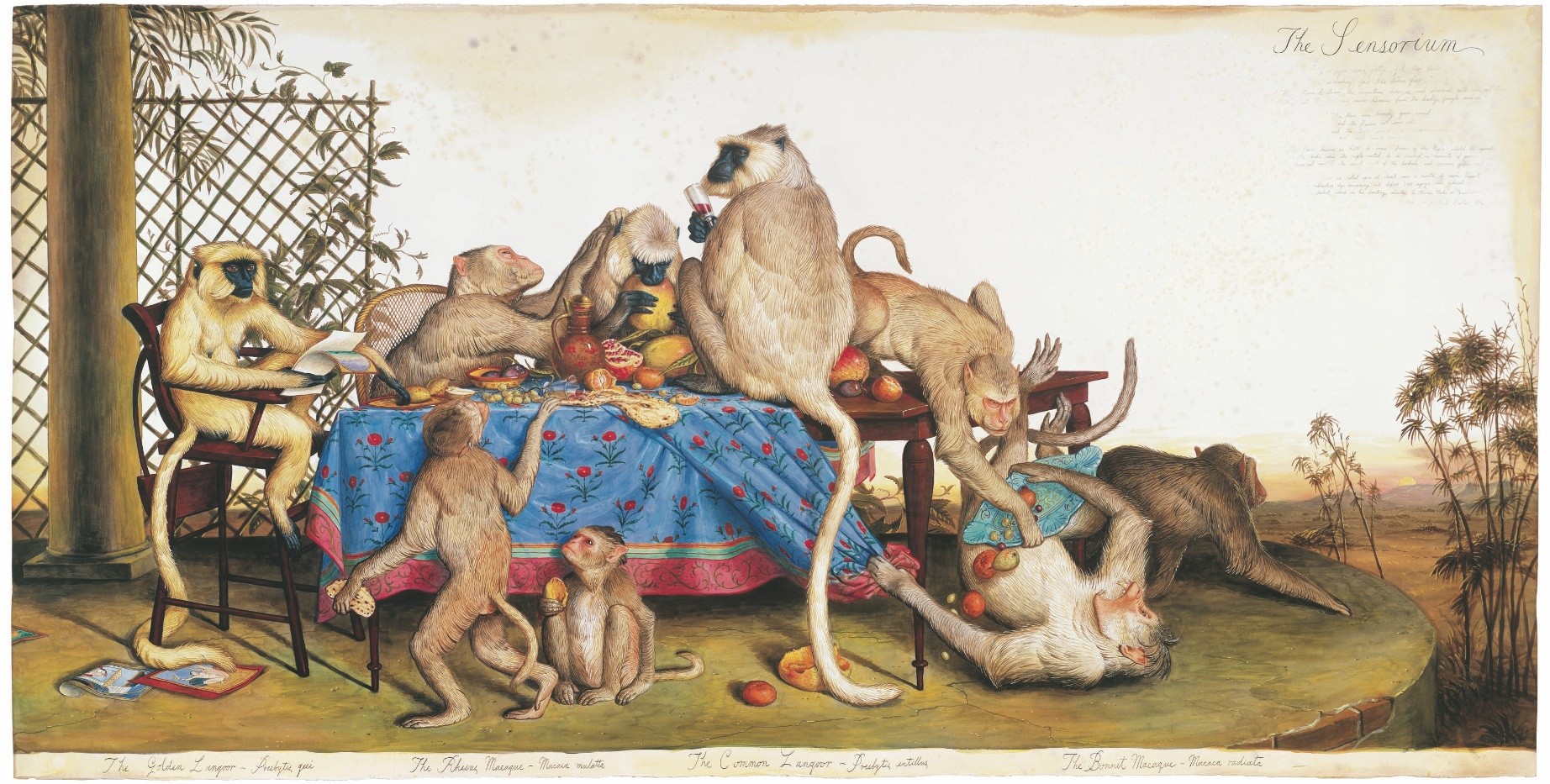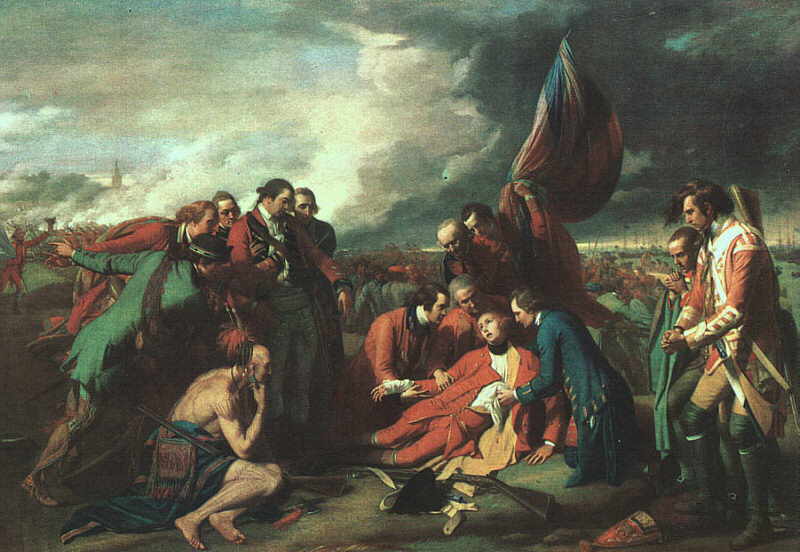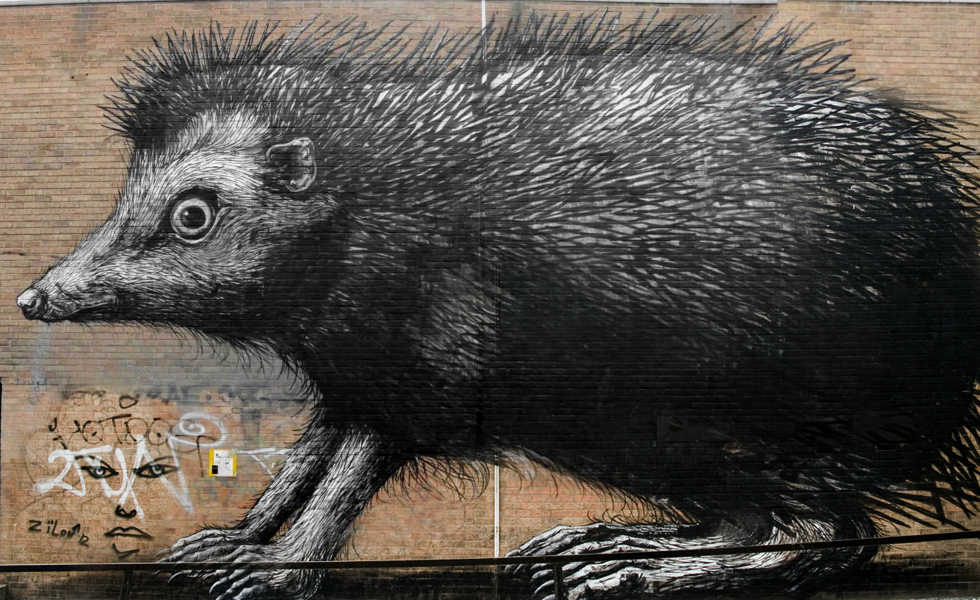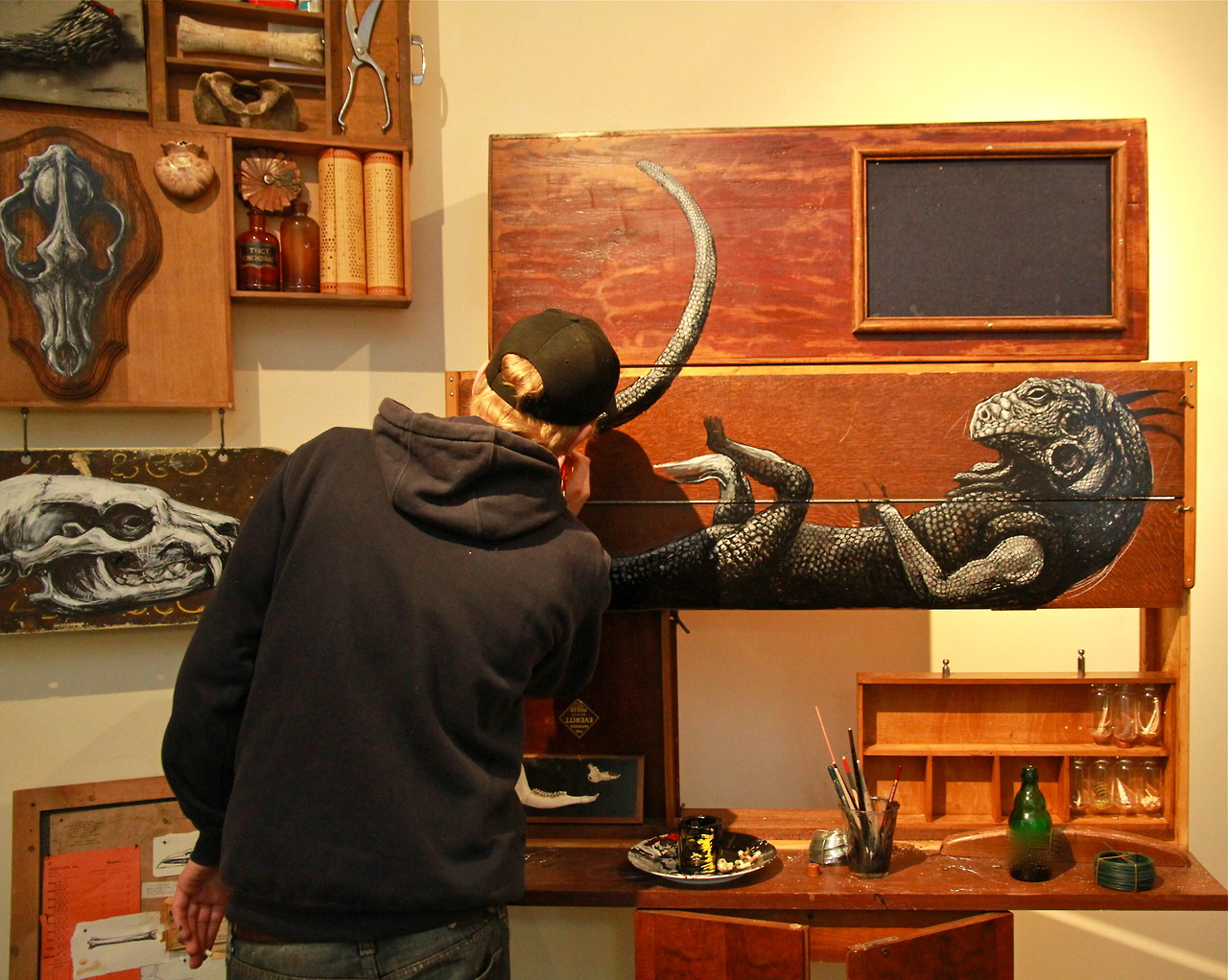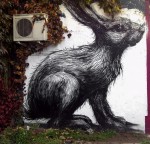WOOHOO new art supplies – I picked up my first acrylic markers (where you babies been all my life) and man, this is a game-changer.
This page all started from an Albrecht Dürer illustration of the wing of a blue roller that’s been making its rounds on the Tumblrverse… And also the Song off the MIA/ Diplo mix album, Definition of a Roller… But yeah, decocolor markers. Pretty amazing. As always this is in my Moleskine… if you like to beat the heck out of your sketchbooks and are looking for a nice pocket-style book, you can always get a Moleskine for yourself.
The charming and talented Montreal artist Peter Ferguson will be in Seattle this Friday for the opening of his solo show, “Black Jubilee” at Roq la Rue.
I’ve mentioned Peter Ferguson before but just as a refresher, he is a wonderfully talented Montrealer that I have the good fortune to count amongst my friends. He has worked as an illustrator and artist for many years, and as I was saying, his show opens this Friday at Roq La Rue Gallery in Seattle.
Hi-Fructose has a pile of pieces up on their site, so go check that out if you want to see more (and who wouldn’t really) and if you are in the Seattle area, be sure to stop by and check out these exquisite paintings in person because wee little images on the interwebs do not do them justice.
I won’t get to see the show in person, unfortunately, but I have seen most of these paintings and I assure you, it is very much worth your while to head on out to Roq la Rue and check out Peter’s work in person.
It probably comes as no surprise to anyone that I spend a lot of time on the internet, and a large portion of that time is bombarding myself with images – tumblr blogs, pinterest, artist blogs, online magazines, self-imposed google image search scavenger hunts, you name it. This is why every now and then, for all the vast amounts of dross, I have the good fortune to discover a brilliant gem that I have never heard of before and get my mind blown. Like, say, the work of Walton Ford.
Pretty astonishing,right? This description of his book Tigers of Wrath, Horses of Instruction pretty much sums it up:
The paintings of Walton Ford (b. 1960) combine superb draftsmanship with layers of allegorical and lyrical symbolism. “It’s as if John James Audubon had been visited by the spirit of Hieronymous Bosch” is how one critic has described the unsettling impact of Ford’s powerful works, with their sometimes violent imagery and their trenchant political and social commentary on history, colonialism, and the precarious relationship between man and animal.
This striking volume is the first overview of Ford’s dazzling paintings-and the only book currently in print on this increasingly popular artist. Printed to coincide with a Ford exhibition at the Paul Kasmin Gallery in New York, the book includes an essay by screenwriter Steven Katz and an interview with the artist by Dodie Kazanjian, who, in a recent article in Vogue, concluded: “A Walton Ford painting can be enjoyed on many levels, but it just so happens that the entry level is dazzling draftsmanship and sheer, knockout visual pleasure.”
This encapsulates Ford’s work neatly, especially the phrase “as if John James Audubon had been visited by the spirit of Heironymus Bosch”. …and then went on to create intensely detailed renderings in watercolour of animals in allegorical scenes, echoing historical paintings and mythology. Unfortunately, a critical aspect of Ford’s work that the internet is really lame at communicating is its scale. These are no mere exquisitely detailed illustrations in a handy pocketbook, these are epic.
Not only is Ford’s work a stunning display of mastery and grandeur, but the guy has a sense of humour which is always a bonus. As a Canadian, I grew up with this famous painting appearing in my history books throughout school:
Here we have the death of General Wolfe (leader of the British forces) dying of his wounds at the Battle of the Plains of Abraham (the Battle of Quebec, 1759) where the British defeated the French, basically conquering what is now Canada. The general of the French forces (Montcalm) died that day too, so don’t feel to bad for this guy.
…and here’s Ford’s take on it, a series of hand-made prints (6 copper plates, hardground etching, aquatint, spit bite aquatint, drypoint, scraping and burnishing on white Rives paper) replacing all the figures with Carolina parakeets, the extinct species that was the only parrot native to the eastern US.

Dying Words (2008)
A sense of humour bordering on Duchampian, I think. Well, I call it a sense of humour. Of course this is not something an artist always wants to hear, as art tends to take itself pretty seriously. In the intro to an interview in ArtInfo, the writer states “Repurposing a field-guide aesthetic, Ford composes dense allegories that make sometimes pointed, sometimes sidelong allusions to everything from conservationism and consumption to war, politics and imperialism.” Sure, that’s one way of looking at it. Another way of describing this is a sense of humour. Not in the sense of a joke (per se) but cocking a snook at the gravitas of history itself. Humour is an essentially anti-authoritarian stance that underpins a good majority of postmodernism, I suspect, but everyone’s so scared of being accused of revealing that the Emperor wears no clothes that they feel that they have to daintily position themselves within very academic contexts when describing art, essentially neutering the anarchic power that humour wields. But I digress.
Some of my contemporaries are just interested in talking about fashion or pornography. You have an American Apparel-style theory of making art, and I couldn’t be more bored with that. But that seems to be all that some painters seem to be interested in now.
And I think, “God, you know, look at what’s happening in the world. Is that your preoccupation: Celebrity, glamour and pornography? Is that really what we’re going to go down in flames celebrating?”
I’m more interested in the project that I’m working on, which has to do with natural history and human culture and the intersection between them.
I am less interested in engaging issues of contemporary theory or something. My work reacts to the history of natural history and the history of people’s interactions with animals and other cultures and things like that.
– Walton Ford, ArtInfo (2007 interview with William Hanley)
So there you have it. Walton Ford is awesome and you should check out more of his stuff. The book Pancha Tantra includes an excellent selection of his work at an excellent price (thanks, Taschen) but if you’re feeling spendy there’s always Tigers of Wrath, Horses of Instruction. If you’re a traveller, Ford’s work is included in the collections of the Honolulu Museum of Art, MOMA, the Smithsonian, and the Whitney. He is represented by the Paul Kasmin Gallery in NYC.
Today, a collage. I’ve been reading a lot of J.G. Ballard lately, what can I say?

My source materials for this digital collage were images of the 15-year-old Elizabeth Taylor, the arm of a Hitachi hydraulic excavator, a vintage Plymouth Fury, and a photo of the first underwater nuclear explosion (Operation Crossroads, 1946)
What actually happens on the level of our unconscious minds when, within minutes on the same TV screen, a prime minister is assassinated, an actress makes love, an injured child is carried from a car crash? Faced with these charged events, prepackaged emotions already in place, we can only stitch together a set of emergency scenarios, just as our sleeping minds extemporize a narrative from the unrelated memories that veer through the cortical night. In the waking dream that now constitutes everyday reality, images of a blood-spattered widow, the chromium trim of a limousine windshield, the stylised glamour of a motorcade, fuse together to provide a secondary narrative with very different meanings.
– J.G. Ballard, the Atrocity Exhibition
ROA is a Belgian native whose work is well-known enough that most people familiar with contemporary street art in even the vaguest way will recognize his work. In 2010 the landmark lawsuit to preserve his (legal) work in Hackney helped pave the way for street art preservation throughout the UK and did a lot to improve the public perception of the value of *ahem* “uncommissioned public art” in general.

ROA – Hackney
Here’s another recent piece from ROA in Shoreditch. ROA put this piece up in conjunction with an art show in London back in April of last year.
Note the small addition by Montreal’s own Zilon in the bottom left…
Anyhow, in case you hadn’t figured it out yet, ROA is really prolific, very well-known, and has work all over the world. Mostly these giant animals. I say mostly, because occasionally he does some really interesting installation work combining artwork and wunderkammer-like displays. Checking out Vandalog (as I am wont to do), I see that ROA (or is it Roa now?) has his first solo gallery show in his native Belgium, and it is indeed an installation that has more in common with a biologist’s laboratory than street art.
As we previewed on Sunday, Roa has a solo show, Stop Over, open now at BODSON-EMELINCKS in Brussels. So glad to see Roa finally getting a full-fledged solo show in his home-country of Belgium. Looks great.
– Vandalog
Here’s a shot of ROA at work setting things up:
As a collector of oddities and a lover of nature, pathology, and art (of course I have cupboards full of bones and a pile of old medical texts, who doesn’t?) I am in love with this work in too many ways to describe. Anyone have a round-trip ticket to Brussels (location corrected, oops) they don’t need? Check out these shots of the show by Henrik Haven.
- ROA – Hackney
You can check out more of ROA’s work on his Tumblr blog or his Flickr feed, or see a complete slideshow of ROA’s Stop Over on Vandalog.



